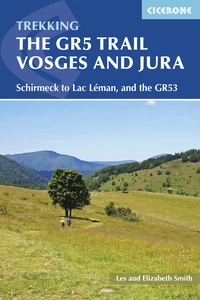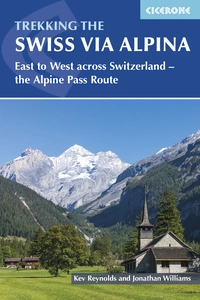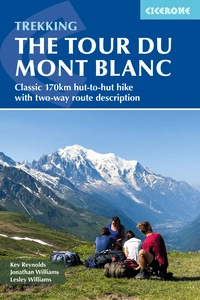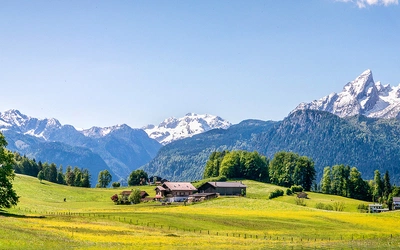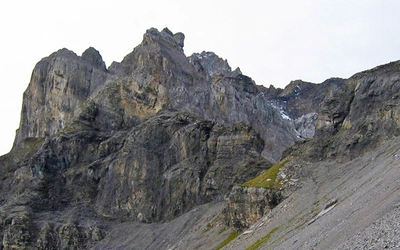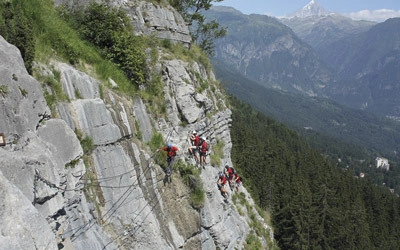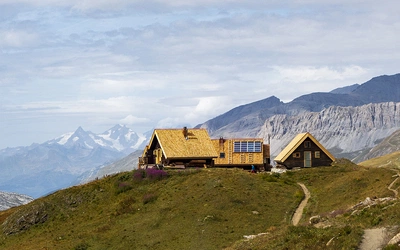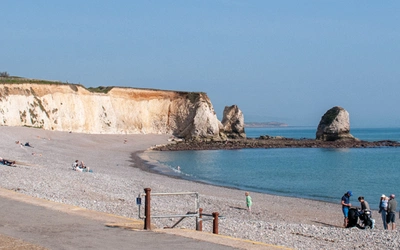Crossing the Crête des Gittes on the GR5
The GR5 is one of the world's classic treks. The section through the French Alps takes nearly a month and involves long distances, big climbs and staying in high mountain huts. Jonathan Arlan chose it as his first long distance walk. Literally. Here, he recounts a tough section that he encountered early on in the trek: the infamous Crête des Gittes ridge.
God, this sucks, I thought. I’d only been out for a short time, maybe 45 minutes, but the day before had been punishing, and so far I’d been climbing without a break. I stopped to rest near a concrete bunker that looked like it had seen some action in World War II and then been left to crumble ever since. It seemed an appropriately broken place to drop my bag and collapse, like a marionette with all its strings cut at once.
In between gulps of water from a bottle that felt absurdly heavy in my hands, I skimmed my guidebook, a resting ritual that was rapidly developing into an obsessive habit. Climbing, descending, climbing, eating, sleeping, descending—a loop that went on, apparently, as long as I wanted it to. Every day the terrain from here to the ocean looked exactly the same – alternate woods, meadows and bare rock – but for the most part one day's walk looked a lot like all the others. This was not necessarily a bad thing (or a true thing, even), but in that moment, stiff from a bad night’s sleep and tired from a tough climb first thing in the morning, it was all I could think about: in other moments, the monotony and repetition were aspects I actually looked forward to.

I was several days into a walk that would take me from the rain-slicked emerald hills south of Lake Geneva, over the High Alps (and the slightly-less-high Alps), through the sun-battered rocky humps of southeast France and, if everything went according to plan, to the cool blue waters of the Mediterranean Sea. The plan was very simple: don’t stop walking, don’t get hurt, don’t die: at the end, I imagined, I would sink to my knees, raise my arms above my head and shout victoriously at the top of my lungs: vacationers be damned, I’d walked the Alps! The GR5: the Grandes Traversée des Alpes! Hundreds and hundreds of miles! Alone! On my own two feet! Me, a soft, nervous, nerdy, Brooklynite with about as much previous mountain walking experience as moon walking experience.
That was the dream, anyway: and, in those early days, it was a damn powerful one. The problem, of course, was reality.
And the reality was that walking the Alps was turning out to be much more difficult than I’d led myself to believe. Before I’d started, all I’d had to go on were the reports of other hikers, which I read selectively (careful not to discover anything that might turn me off to the idea), and fuzzy memories of long, aimless city walks I had taken over the years. City walking, however, is not like mountain walking, a fact that should have been obvious, but wasn’t. This disconnect (let’s call it a learning curve) was no one’s fault but my own. I’d done almost no training, no research, no day hikes around my house, no squats, or sit-ups, or jogging, or even purposeful walking, really. But I’d desperately wanted an adventure – that’s why I was there, I reminded myself – and the Alps were going to give it me.

I flipped back to the page that outlined the day’s route and found a paragraph I’d somehow missed, despite having read it half a dozen times: ‘The walk along the Crête des Gittes is inadvisable in very strong wind, or if snow and ice covers the path.’ The Crête des Gittes, I read, is a high, narrow ridge on the far side of the already high pass I had to cross that day. The path lies on the needle-fine point of a rocky triangle that drops dangerously on both sides. A photograph in the book of two smiling hikers preparing to cross made my stomach turn. I looked into the distance to see if I could see it, but all I saw were mountains. Then I remembered that rain had been forecast for the afternoon. Did a warning against crossing in strong wind also apply to crossing in rain? I sat for a minute and thought about turning back to wait for better weather. But the weather was already perfect, and the people at last night’s refuge would laugh me off the mountain. Keep walking, I thought. Keep walking. Always, no matter what, keep walking.
So I walked, very slowly, toward the Col du Bonhomme – the col before the Crête – which was still hours away. A Frenchman, who was hiking with his wife and two young daughters, caught up with me later in the morning. He was alone. He and his family had stayed at the same refuge as I had last night, and I had managed to speak with the him for a few minutes before the guests were separated by nationality. He was in his forties and, like almost everyone else I met, fit enough to run circles around me. Not surprisingly, so were his wife and daughters. They were the picture of a French mountain climbing family: blond hair falling on the heavy packs they shouldered without complaint as they bounded up and down the mountains. They were on the Tour du Mont Blanc, he told me. It was his fourth time around, his wife’s second or third, but his kids' first. When he was younger, he had completed the circuit faster, in about six days, by running long stretches of it: now they would take about two weeks, depending (depending on what I'm not sure, since they all looked more than capable of crossing the entire country in two weeks).
While he waited for his family to catch up, I asked if he had ever crossed the Crête des Gittes.
‘No,’ he said, looking at the picture in my book, ‘but it looks amazing’.
‘It looks scary,’ I said. ‘What if I slip?’
‘Don't slip.’
‘But it's supposed to rain this afternoon, and my book warns against crossing in bad weather.’
He craned his head up at the sky, which was so clear it looked incapable of ever producing clouds at all.
‘I don't think it will rain. Just walk quickly. And don't slip.’
Buoyed by our talk, I left him to wait for his family. The path had climbed high enough that I'd crossed the tree line a while back. It felt nice to be out of the woods for the day, and as long as it didn't get too hot the high mountains were preferable if for no other reason than the incredible views. When it did get too hot, of course, I couldn't have cared less about the views.

With the sun still rising, the mountains to the south organized themselves in fading silver ridges as far as I could see. To my right, a massive peak – probably the Aiguilles de la Pennaz – shot theatrically into the sky. I could see ice high up on the mountains to the left. Before me, the trail dipped and rose softly over green hills, an unbroken white line 1m (3ft) wide and pocked with millions of holes left by walking sticks. I had read that the path I was walking was on one of the old salt routes that stretched from the ports in the south to all parts of France. For centuries caravans had moved across the same lines and seen the same peaks and valleys, the same plots of land, and the same chalets and rivers. History had literally been walked into the ground, and I was adding another layer to the story – a micron-thin, totally inconsequential layer, but a layer nonetheless.
I reached the Col du Bonhomme around 0930. I was making excellent time, and there was a chance I could be across the Crête des Gittes before the afternoon rain started. A sad little monument displayed the altitude (2329m, or almost 8000ft) and gave the times needed to reach various points on the trail: but, as far as I could tell, all of the places listed were behind me. Suddenly I felt very lost. I checked the book again. I was in the right place, an hour from the Croix du Bonhomme, 90m (300ft) above me. Once there, I would have no choice but to step onto the ridge and put my life in the hands of the mountain.

Actually, that's not entirely true: there is an alternate path that follows the Tour du Mont Blanc to Les Chapieux, where you can take a road and reconnect to the route I was on. Although this was mentioned very clearly in my guidebook, I didn't notice it until weeks later. It's hard to say if it would have made any difference.
I was sitting with my back against the monument, lost in doomsday weather predictions – a smear of white clouds had appeared in the sky, way off to the east – when the French family came running up the mountain behind me. The father shook my hand, helped me to my feet, and congratulated me on making it to the col. I hadn't thought of it as an achievement worthy of congratulations, but why not? We'd made it. It was hard work – more than 3000ft in only a couple of hours. And it was gorgeous. I'd congratulated people on far less impressive feats, and anyway, I felt good. My legs were still stiff and rusty in the morning, but after an hour of climbing, they practically pulsed with strength. Standing on the col, with only 300ft of climbing ahead, I was sure I could run the rest of the way. Of course, I didn’t try.
We walked up a steep slab of rock together, the kids jumping like goats, to the Croix du Bonhomme. As we crossed a small stream they each whipped out their water bottles to refill them with what seemed to me dangerously suspect water. I sipped at mine slowly, careful not to empty it. After a short, slippery climb to the top, we all shook hands and they peeled down the mountain to the left while I looked ahead in abject terror. I held the photo of the Crête up and compared it to the real thing. The photographer must have worked hard at making it look less scary, because from where I was standing, it seemed impossible to cross without falling. Plus, clouds were actually gathering now in purple–gray popcorn kernels directly above. The sky darkened. My stomach sank. A trio of middle-aged men passed by and climbed to the start of the ridge. I hurried to catch up, thinking it would be better to tag along with perfect strangers, particularly French strangers, than to go it alone.

Nearly level with the top of the ridge the trail, just barely scraped out of the side of the mountain, looked incredibly long, like it would never end. A slip, if you couldn't catch yourself in time, might truly mean tumbling clear down to the bottom. I tried not to think about that: I tried, instead, to think about how good it would feel at the other end. I tried to think about how unlikely it was that I would actually fall. After all, I had never heard of anyone falling from the Crête des Gittes. Never mind that I had never even heard of the Crête des Gittes until earlier that day. I tried to think about the ocean, the way the water would feel on my scorched skin. I did not look down, or up, or off to the sides. I kept my eyes on the path ahead of me, on the back of the feet of the men in front of me.
The men moved quickly, easily. It was nothing to them. They could have been on a day hike, for all I knew, and would be crossing back the other way later that afternoon, rain or shine, or maybe the next day on their way home. They were free to enjoy this in a way that I was not – at least not yet: I hadn’t earned it, hadn’t spent enough time in the mountains. So for the time being I would suffer through it. The path rose and fell: we climbed and descended 15, 20 feet each time. It stuck to the east side of the mountain, then switched to the west. I lost track of time, but I must have been on it for half an hour before I could see what I hoped was the end. When I got there, ten minutes later, it was not the end but another in a series of blind climbs to yet another stretch of the ridge.
Finally, the line stopped abruptly and fell hundreds of feet in short, sharp zigzags down the mountain. Here, I thought: here is where I fall and die. An old man asked if he could go ahead of me and said to take my time, be careful, ‘go slow, go slow.’ Slow it was – painfully, dreadfully slow – as I placed each foot on the ground, tested the rocks below for slippage and held my breath when I shifted my weight. Every few steps I slipped anyway, a fraction of an inch, which isn't much, but it's enough. I looked back. Again, a line of hikers had formed behind me. I stepped aside to let them pass, which they did with big, bouncy steps. I could see people at the bottom, so small from this high up. Halfway down, my knees were in serious pain. There must be a technique for descending steep trails, I thought, but I didn't know it. My arms were starting to cramp, too, from the force I put on my walking sticks when I stabbed them murderously into the ground. When I finally took the last step off the ridge onto a big, flat patch of soft grass, I collapsed in a pile of dead limbs and sweat-drenched clothes. The three men who started with me applauded and raised their water bottles in my direction. One walked over to me and handed me a candy bar without saying a word.

I ate my lunch like a starved soldier, calming my jittery nerves with sandwiches and peanut butter and chocolate. I looked up at the Crête and could hardly believe I had crossed it. My guidebook downplays the walk, calling it a ‘fine stretch’ and boiling the death-defying descent down to five plain words: ‘zigzag down to a col.’ But it felt much bigger than that, more challenging and, accordingly, more rewarding, something that had taken all my concentration and all my physical coordination and left me empty and buzzing at the other end. Adventure, I thought theatrically. What would it be without fear, or pain, or surprise, or drama?
In the euphoric relief of not being up on the path I lost track of the clouds, which, now that I was paying attention, were blotting the sky completely. Lying on my back in the soft grass, too ecstatic or too tired to move, I closed my eyes, felt cool drops of rain land on my skin, and turned my attention once again to the sea at the end of the trail.



